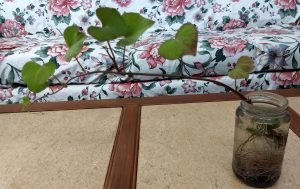A Sweet Story
–Ed.
Although we don’t have a Homa farm, Richard and I have grown wonderful produce in our garden here in Madison, Virginia with Agnihotra and Agnihotra ash. Several people near us do Agnihotra and the Parama Dham fire temple is within walking distance, so our plants get extra exposure to Homa atmosphere. Normally, four hours of Om Tryambakam Homa are done daily at Parama Dham, with additional hours on no moon and full moon days.
In recent years we have grown our own sweet potato plants–a small step toward self-sufficiency.
(Important note–Though they may look alike, sweet potatoes are grown differently than yams, and yam leaves are not always edible.)
In January, we cut two or three sweet potatoes in half and suspend the cut potato about halfway in a solution of water with a little Agnihotra ash added to it.

Soon sprouts begin to form, which then grow to form vines.

When the vines are about nine inches long, we gently twist the vines from the chunk of potato, then put them in jars of water mixed with a little Agnihotra ash. Very soon, roots begin to form.

When the roots have developed and all danger of frost has passed, we plant the vines outdoors, adding Agnihotra ash to the soil.

To save time on weeding, we suppress weeds with sheets of used cardboard obtained free from a local business.

When the plants have attained substantial growth, some of the leaves are harvested for use. They have a very mild flavor and are highly nutritious.

A few weeks before harvesting the sweet potatoes, we can actively begin to harvest the leaves (before any frost). They can be used fresh in cooking and salads, or dehydrated and stored for use in soups and smoothies during the winter months.
Finally, the harvest! All these sweet potatoes (minus some that were already eaten) and greens started from just two sweet potatoes. (Actually, there could have been many more, but we didn’t have room to plant all of the plants produced by the two original sweet potatoes. Also, we ran out of time and couldn’t dry all the leaves before the frost, but our cows were happy to eat what was left.) Both the tubers and their greens are nutrient-rich, making them good survival foods. We store the tubers in a dry, dark place, making sure to set aside two of the best ones for growing next year’s plants.

In our experience, you don’t need to be an expert gardener to reap abundant produce using Agnihotra and Agnihotra ash. We wish you success in your own Agnihotra garden!



